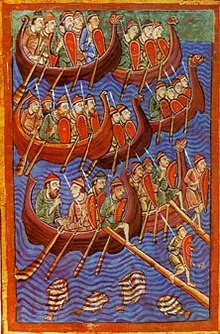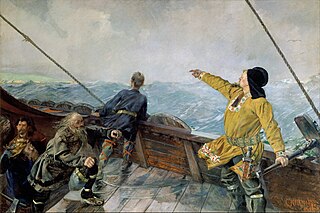
Adam of Bremen was a German medieval chronicler. He lived and worked in the second half of the eleventh century. Adam is most famous for his chronicle Gesta Hammaburgensis ecclesiae pontificum. He was "one of the foremost historians and early ethnographers of the medieval period".
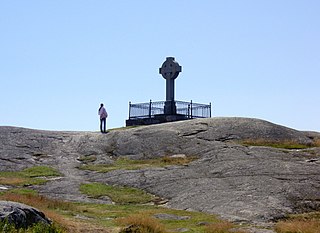
Birka, on the island of Björkö in present-day Sweden, was an important Viking Age trading center which handled goods from Scandinavia as well as many parts of the European continent and the Orient. Björkö is located in Lake Mälaren, 30 kilometers west of contemporary Stockholm, in the municipality of Ekerö.
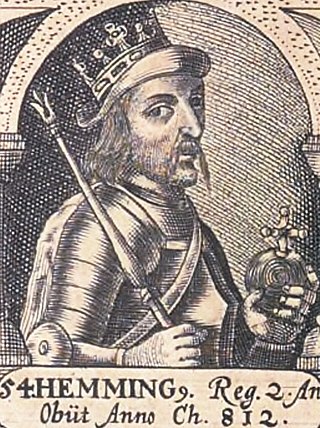
Hemming I was a king in Denmark from 810 until his death. He was the successor of King Gudfred, his uncle.
Saint Rimbert was archbishop of Hamburg-Bremen, in the northern part of the Kingdom of East Frankia from 865 until his death in 888. He most famously wrote the hagiography about the life Ansgar, the Vita Ansgari, one of the most popular hagiographies of middle ages.

The Temple at Uppsala was a religious center in the ancient Norse religion once located at what is now Gamla Uppsala, Sweden attested in Adam of Bremen's 11th-century work Gesta Hammaburgensis ecclesiae pontificum and in Heimskringla, written by Snorri Sturluson in the 13th century. Theories have been proposed about the implications of the descriptions of the temple and the findings of the archaeological excavations in the area, along with recent findings of extensive wooden structures and log lines that may have played a supporting role to activities at the site, including ritual sacrifice. The temple was destroyed by King Inge the Elder in the 1080s.

Skálholt is a historical site in the south of Iceland, at the river Hvítá.
Emund Eriksson, , was a Swedish king whose historicity is only known from a single source, the Gesta Hammaburgensis ecclesiae pontificum which was written by Adam of Bremen in c. 1075.

The Archbishop of Uppsala has been the primate of Sweden in an unbroken succession since 1164, first during the Catholic era, and from the 1530s and onward under the Lutheran church.

Egino was the only bishop of Dalby in Scania, from 1060 to 1066. He was ordained by archbishop Adalbert of the Archbishopric of Bremen. The bishopric was separated from Roskilde in 1060, when the church in Denmark was reorganized in nine episcopal sees, but practically united with the see of Lund in 1066, after the death of bishop Henry of Lund. Thereby all of Terra Scania was subordinated to Hamburg-Bremen.

Harthacnut or Cnut I was a semi-legendary King of Denmark. The old Norse story Ragnarssona þáttr makes Harthacnut son of the semi-mythic viking chieftain Sigurd Snake-in-the-Eye, himself one of the sons of the legendary Ragnar Lodbrok. The saga in turn makes Harthacnut the father of the historical king, Gorm. It has been suggested he is to be identified with the Hardegon of Northmannia whose early-10th century conquest of Denmark was related by Adam of Bremen.

Saint Sigfrid of Sweden (Swedish: Sigfrid, Latin: Sigafridus, Old Norse: Sigurðr, Old English: Sigefrið/Sigeferð) was a missionary-bishop in Scandinavia during the first half of the 11th century. Originally from England, Saint Sigfrid is credited in late medieval king-lists and hagiography with performing the baptism of the first steadfastly Christian monarch of Sweden, Olof Skötkonung. He most likely arrived in Sweden soon after the year 1000 and conducted extensive missions in Götaland and Svealand. For some years after 1014, following his return to England, Sigfrid was based in Trondheim, Norway. However, his position there became untenable after the defeat of Olaf Haraldsson.
Harald 'Klak' Halfdansson was a king in Jutland around 812–814 and again from 819–827.
Terra feminarum is a name for an area in Medieval Northern Europe that appears in Gesta Hammaburgensis Ecclesiae Pontificum by Adam of Bremen 1075 AD.

The sacred tree at Uppsala was a sacred tree located at the Temple at Uppsala, Sweden, in the second half of the 11th century. It is not known what species it was. Older sources have described it as an ash tree, but Frits Läffler have suggested that it was a yew tree.
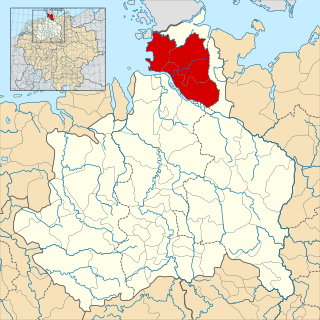
Nordalbingia was one of the four administrative regions of the medieval Duchy of Saxony, the others being Angria, Eastphalia, and Westphalia. The region's name is based on the Latin name Alba for the Elbe River and refers to an area predominantly located north of the Lower Elbe, roughly corresponding with the present-day Holstein region. Situated in what is now Northern Germany, this is the earliest known dominion of the Saxons.
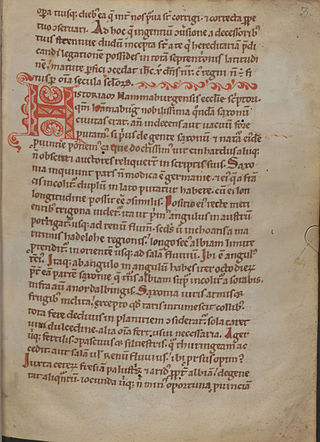
Gesta Hammaburgensis ecclesiae pontificum is a historical treatise written between 1073 and 1076 by Adam of Bremen, who made additions (scholia) to the text until his death . It is one of the most important sources of the medieval history of Northern Europe, and the oldest textual source reporting the discovery of coastal North America.

This Viking Age runestone, designated as G 181 in the Rundata catalog, was originally located at a church at Sanda, Gotland, Sweden, and is believed to depict the three Norse pagan gods Odin, Thor, and Freyr.

The Curonians or Kurs were a medieval Baltic tribe living on the shores of the Baltic Sea in the 5th–16th centuries, in what are now western parts of Latvia and Lithuania. They eventually merged with other Baltic tribes contributing to the ethnogenesis of present-day Latvians and Lithuanians. Curonians gave their name to the region of Courland (Kurzeme), and they spoke the Curonian language.

Hilgenried Bay is a bay on the German North Sea coast near Hilgenriedersiel, a village in the municipality of Hagermarsch in the Lower Saxon county of Aurich. It was probably formed during the Dunkirk transgression as a result of the washing out of the mouth of one or more small streams, but has now largely silted up.
Werner of Steusslingen was the archbishop of Magdeburg from 1063 until his death. His episcopate was dominated by the Investiture Contest. He was an ally of King Henry IV of Germany until 1073, when he joined the first Saxon revolt. Imprisoned in 1075 and released the following year, he joined the second Saxon revolt in 1077. He was killed at the battle of Mellrichstadt.
